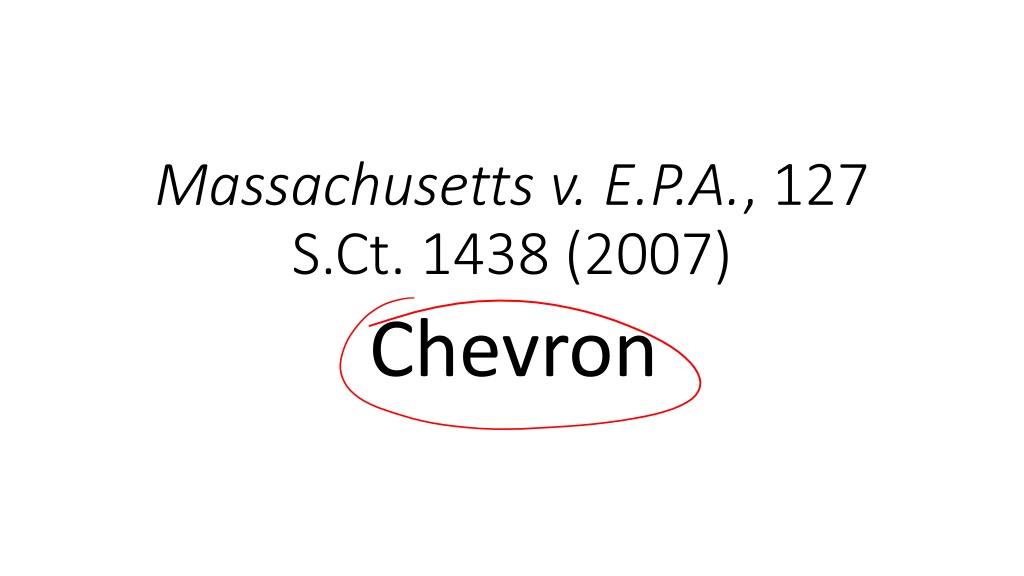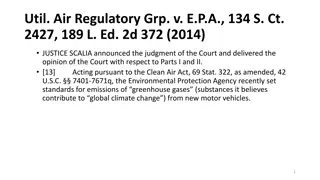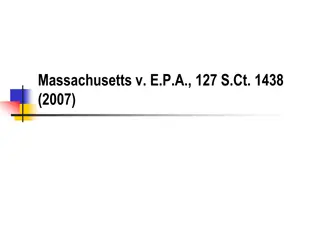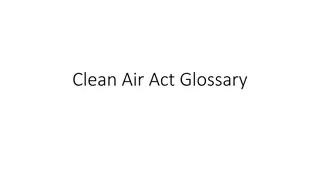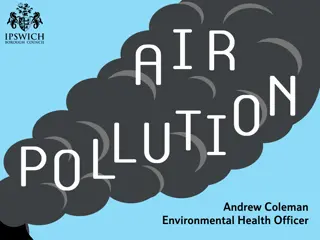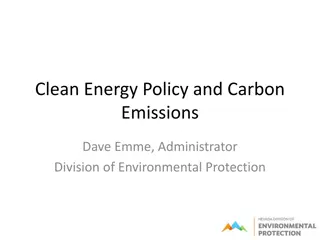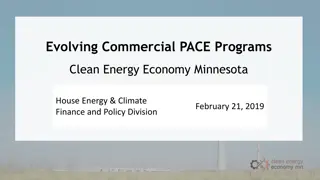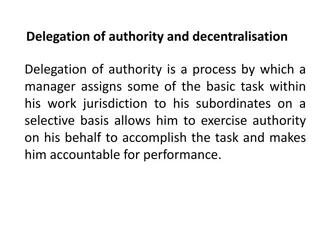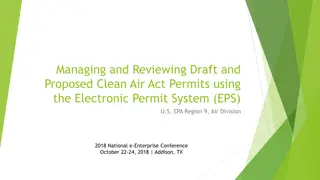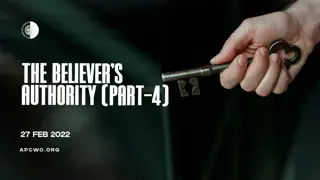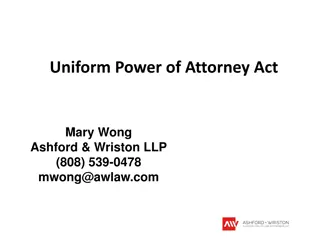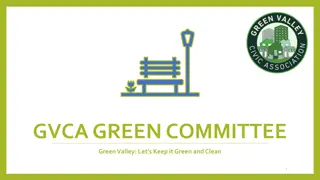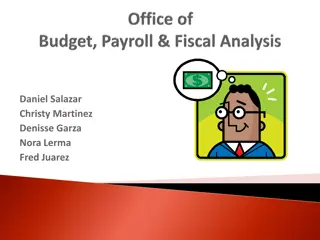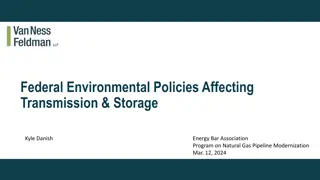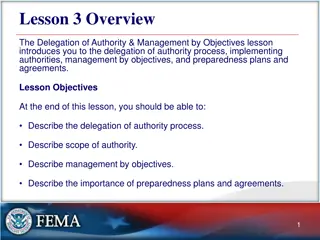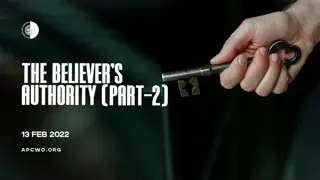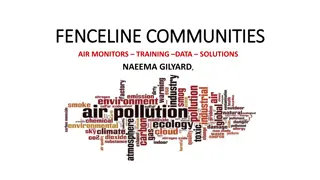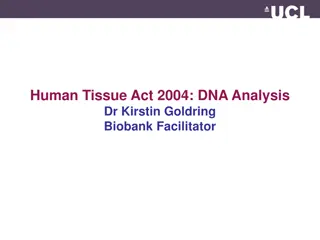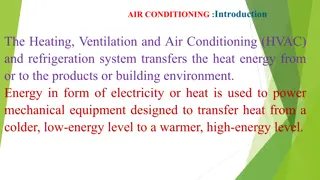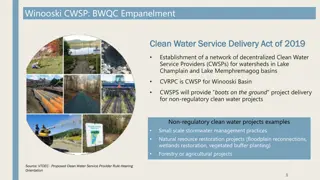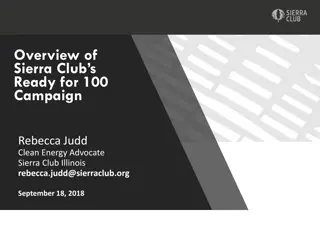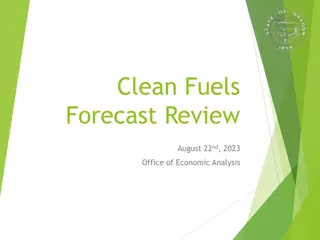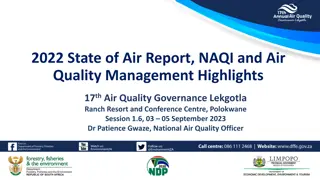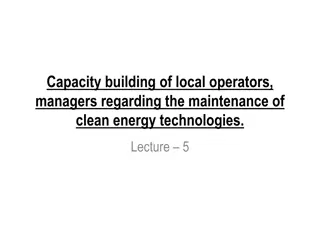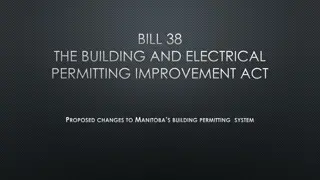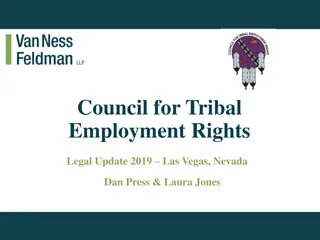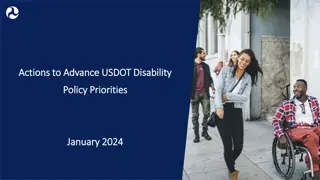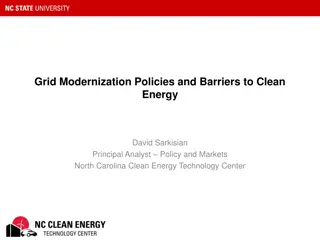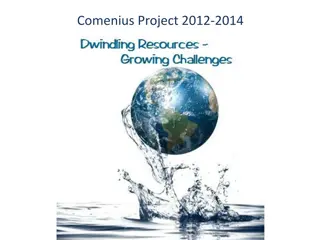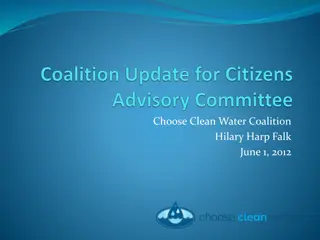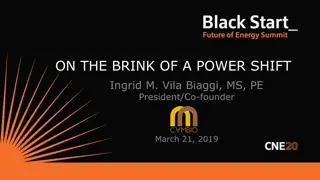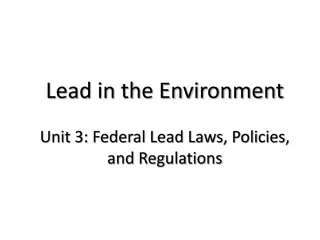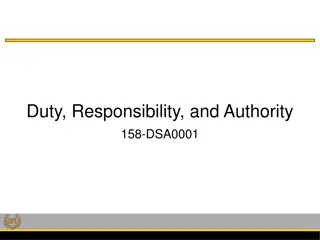Analysis of EPA's Authority to Regulate GHGs under the Clean Air Act
Massachusetts v. EPA (2007) addressed whether the Clean Air Act allows regulation of greenhouse gases (GHGs). EPA's findings on the rulemaking petition questioned its authority to regulate GHGs despite previous claims. The Act mandates EPA to issue regulations on air pollutants emitting from new motor vehicles that endanger public health or welfare, including climate effects. The Court uses the Chevron case to interpret the Act's ambiguity regarding GHGs. The EPA's rule in Chevron focused on regulating facilities holistically to monitor air pollution emissions.
Uploaded on Sep 20, 2024 | 0 Views
Download Presentation

Please find below an Image/Link to download the presentation.
The content on the website is provided AS IS for your information and personal use only. It may not be sold, licensed, or shared on other websites without obtaining consent from the author. Download presentation by click this link. If you encounter any issues during the download, it is possible that the publisher has removed the file from their server.
E N D
Presentation Transcript
Massachusetts v. E.P.A., 127 S.Ct. 1438 (2007) Chevron
Does the CAA Allow Regulation of GHGs?
What were EPAs Two Findings When it Answered the Rulemaking Petition? (1) that contrary to the opinions of its former general counsels, the Clean Air Act does not authorize EPA to issue mandatory regulations to address global climate change, see id., at 52925-52929; and (2) that even if the agency had the authority to set greenhouse gas emission standards, it would be unwise to do so at this time. The EPA had previously said it had the authority to regulate GHGs. By denying it had the authority, it gave the court a pure legal question to answer could the CAA cover GHGs? 3
What does the Clean Air Act 7521(a)(1) require the EPA to issue regulations on? [35] "The [EPA] Administrator shall by regulation prescribe (and from time to time revise) in accordance with the provisions of this section, standards applicable to the emission of any air pollutant from any class or classes of new motor vehicles or new motor vehicle engines, which in his judgment cause, [key to the dissent] or contribute to, air pollution which may reasonably be anticipated to endanger public health or welfare ... [36] The Act defines "air pollutant" to include "any air pollution agent or combination of such agents, including any physical, chemical, biological, radioactive ... substance or matter which is emitted into or otherwise enters the ambient air." 7602(g). "Welfare" is also defined broadly: among other things, it includes "effects on ... weather ... and climate." 7602(h). 4
Is the Statute Unambiguous? This Court uses the rule from the Chevron case to decide what the CAA means for GHGs. West Virginia v. EPA case - the Court abandons Chevron and redoes the analysis with the major questions test. The question in Chevron was how should the EPA monitor air pollution emissions in large industrial facilities with many sources of air pollution? 5
The EPA Rule in Chevron The EPA promulgated a rule that regulates the facility as a whole - measuring the air pollution as if the faculty is in a bubble. Environmental groups sue, arguing that the EPA should require pollution from each source to be measured. The Clean Air Act does not give specific direction on this question. How should the Court decide whether the rule is allowed under the CAA? The court could read the statute on its own and decide the best approach, effectively making the regulatory policy decision. The court could defer to the agency. (This is not a new problem (Skidmore and Hearst are from the 1940s), but this is the first case to articulate a test for deciding which path to take.) 8
Chevron - Step One Does the statute clearly prohibit or clearly allow the rule? The Court decides this question using traditional tools of statutory construction, e.g., text, structure, statutory purposes & findings, legislative history. No deference to the agency at this stage. If clearly prohibits the rule, then the court is done. If it clearly allows the rule and no other rule, the court is done. If it is ambiguous it allows many rules but it does not give clear guidance on the best rule then the court goes to Step Two. 9
Chevron Deference - Step Two If statute is ambiguous, or if Congress left gaps for the agency to fill, Chevron assumes that this means Congress is leaving the policy choice of rules to the agency. The agency s interpretation of the statute has to be reasonable. This might be questioned based on the cost of compliance. The agency is entitled to deference if its interpretation is reasonable. The agency s interpretation need not be the best or the one preferred by the court. Conservative critics of regulation hate Chevron, at least until they get control of the EPA. Environmentalists, as in the Chevron case itself, argue against deference when the EPA uses it to weaken or not make regulations. 10
Chevron Step 1 Brown and Williamson Variation Even if the statute is clear, is it really what Congress meant? The Food, Drug, and Cosmetics Act says anything that is sold to affect the structure and function of the body is a drug. Under the plain language, tobacco would be a drug under the FDCA. Drugs can only be licensed for interstate sale if they are safe and effective as labeled for use. If tobacco is a drug, it would have to be banned under the statute. Congress clearly did not want to ban tobacco, so the FDCA does not mean that the words say. This became the Major Questions Doctrine. 11
Remember that this is for mobile sources Chevron Step 1 Applied in This Case [36] The Act defines "air pollutant" to include "any air pollution agent or combination of such agents, including any physical, chemical, biological, radioactive ... substance or matter which is emitted into or otherwise enters the ambient air." 7602(g). "Welfare" is also defined broadly: among other things, it includes "effects on ... weather ... and climate." 7602(h). Broadly read, farts could be pollution and people mobile sources. As with tobacco and the FDCA, did Congress intend the CAA to be broad enough to encompass GHGs? The Majority looks at the legislative history of the CAA and other Congressional actions related to global warming and climate change to determine Congressional intent. 12
What was the National Climate Program Act of 1978? In 1978, Congress enacted the National Climate Program Act, 92 Stat. 601, which required the President to establish a program to "...assist the Nation and the world to understand and respond to natural and man-induced climate processes and their implications..." What does this tell us about concerns with greenhouse gasses (GHG) is it just something Al Gore thought up? 13
What did the National Academy of Sciences Tell President Carter? "If carbon dioxide continues to increase, the study group finds no reason to doubt that climate changes will result and no reason to believe that these changes will be negligible... . A wait-and-see policy may mean waiting until it is too late." Remember the clip from Newsroom? Climate issues might be very different if the world had started an agreement in 1978. 14
What did the Global Climate Protection Act of 1987 require the EPA to do? Finding that "manmade pollution -- the release of carbon dioxide, chlorofluorocarbons, methane, and other trace gases into the atmosphere -- may be producing a long-term and substantial increase in the average temperature on Earth," 1102(1), 101 Stat. 1408, Congress directed EPA to propose to Congress a "coordinated national policy on global climate change... Congress emphasized that "ongoing pollution and deforestation may be contributing now to an irreversible process" and that "[n]ecessary actions must be identified and implemented in time to protect the climate." Who was president in 1987? 15
The First Global Warming Treaty The Kyoto Protocol was the first pure climate treaty. President Clinton wanted the US to participate. Before the conference, the Senate passed this sense of the Senate resolution, voting 95-0: Declares that the United States should not be a signatory to any protocol to, or other agreement regarding, the United Nations Framework Convention on Climate Change of 1992, at negotiations in Kyoto in December 1997 or thereafter which would: (1) mandate new commitments to limit or reduce greenhouse gas emissions for the Annex 1 Parties, unless the protocol or other agreement also mandates new specific scheduled commitments to limit or reduce greenhouse gas emissions for Developing Country Parties within the same compliance period; or (2) result in serious harm to the U.S. economy. No senator would vote for a treaty that imposed stricter requirements on the US than on developing countries. (China and India) 16
Is this like Chevron or Brown and Williamson? How does the EPA argue that CO2 is not covered? 17
What was the EPA Evidence of Congressional Intent? [48] In concluding that it lacked statutory authority over greenhouse gases, EPA observed that Congress "was well aware of the global climate change issue when it last comprehensively amended the [Clean Air Act] in 1990," yet it declined to adopt a proposed amendment establishing binding emissions limitations. Id., at 52926. Congress instead chose to authorize further investigation into climate change. 18
Was there Other Specific Legislation on Global Atmospheric Issues? EPA further reasoned that Congress' "specially tailored solutions to global atmospheric issues," 68 Fed. Reg. 52926 -- in particular, its 1990 enactment of a comprehensive scheme to regulate pollutants that depleted the ozone layer -- counseled against reading the general authorization of 202(a)(1) to confer regulatory authority over greenhouse gases. This becomes prophetic as the Court adopts the MQD for climate regulation in West Virginia v. EPA. 19
Had Congress considered and rejected CO2 Regulation? [50] EPA reasoned that climate change had its own "political history:" Congress designed the original Clean Air Act to address local air pollutants rather than a substance that "is fairly consistent in its concentration throughout the world's atmosphere," declined in 1990 to enact proposed amendments to force EPA to set carbon dioxide emission standards for motor vehicles, ibid. And addressed global climate change in other legislation, 68 Fed. Reg. 52927. [This is a powerful argument and returns to cause problems once the EPA has promulgated a GHG rule for stationary searches.] 20
Administrative Policy Rationale for the EPA Position What did EPA want from Congress before regulating green house gasses? Is there a regulatory conflicts problem with the EPA regulating gasoline mileage, which is also regulated by the DOT? Would an EPA rule make it harder to negotiate a treaty on global warming? How could motor vehicle regulations conflict with the goal of a comprehensive approach to global warming? How could such regulations have weaken the president's ability to persuade developing countries to lower their emissions? 21
How does the Majority Distinguish Brown and Williamson? Would the EPA have to ban CO2, as the court thought it would have to do with tobacco? Does the Clean Air Act include cost-benefit analysis, unlike the FDCA? Are there other laws and agencies dealing with CO2 that would have conflicting goals, as there are for tobacco? What is DOT regulating that affects CO2? Does this conflict? 22
The Majoritys Analysis of the Statute The Clean Air Act's sweeping definition of "air pollutant" includes "any air pollution agent or combination of such agents, including any physical, chemical ... substance or matter which is emitted into or otherwise enters the ambient air ... ." 7602(g). On its face, the definition embraces all airborne compounds of whatever stripe, and underscores that intent through the repeated use of the word "any. Carbon dioxide, methane, nitrous oxide, and hydrofluorocarbons are without a doubt "physical [and] chemical ... substance[s] which [are] emitted into ... the ambient air." The statute is unambiguous. 23
The Majoritys Rejection of the Brown and Williamson Arguments. While the Congresses that drafted 202(a)(1) might not have appreciated the possibility that burning fossil fuels could lead to global warming, they did understand that without regulatory flexibility, changing circumstances and scientific developments would soon render the Clean Air Act obsolete. ... Because greenhouse gases fit well within the Clean Air Act's capacious definition of "air pollutant, we hold that EPA has the statutory authority to regulate the emission of such gases from new motor vehicles. 24
The Majoritys Holding In short, EPA has offered no reasoned explanation for its refusal to decide whether greenhouse gases cause or contribute to climate change. Its action was therefore arbitrary, capricious, . . . or otherwise not in accordance with law. 42 U. S. C. 7607(d)(9)(A). We need not and do not reach the question whether on remand EPA must make an endangerment finding, or whether policy concerns can inform EPA s actions in the event that it makes such a finding. [Remember this is the procedural remedy the plaintiffs get an accurate answer to the petition for rulemaking. They do not get a substantive result a rule.] 25
Scalias Dissent Scalia assumes, as with B&W, that CO2 technically fits into the statute, as tobacco fit into the FDCA. In B&W the agency wanted to regulate, thus the question was whether it had authority to do so. In this case, the agency does not want to regulate, so the question is whether it can decline to regulate. 26
What does In His Judgment (EPA Secretary) Mean? shall by regulation prescribe . . . standards applicable to the emission of any air pollutant from any class or classes of new motor vehicles or new motor vehicle engines, which in his judgment cause, or contribute to, air pollution which may reasonably be anticipated to endanger public health or welfare. 42 U. S. C. 7521(a)(1) This is triggered once it is determined that something can be an air pollutant. Scalia believes that the Majority means to force the EPA to regulate GHGs. 27
Does the Majority Require an Endangerment Finding? The Court, however, with no basis in text or precedent, rejects all of EPA s stated policy judgments as not amount[ing] to a reasoned justification, ante, at 31, effectively narrowing the universe of potential reasonable bases to a single one: Judgment can be delayed only if the Administrator concludes that the scientific uncertainty is [too] profound. Ibid. The Administrator is precluded from concluding for other reasons that it would . . . be better not to regulate at this time. Ibid. 28
The Majoritys Rejection of the Policy Reasons in the Rejection The Court dismisses this analysis as rest[ing] on reasoning divorced from the statutory text. Ante, at 30. While the statute does condition the exercise of EPA s authority on its formation of a judgment, . . . that judgment must relate to whether an air pollutant cause[s], or contribute[s] to, air pollution which may reasonably be anticipated to endanger public health or welfare 29
Is Scalia Correct? The Majority says that it is not requiring an endangerment finding in the holding. Scalia is correct that this appears to conflict with the language rejecting the policy reasons in the response to the petition for rulemaking. Under this reasoning, Scalia dissents, seeing this an unreasonable intrusion of the court into a political question. 30
What does Mass v. EPA Really Say? Can the rejection of the reasons in the petition be reconciled with retaining the secretary s discretion to determine whether to regulate an air pollutant? Obama EPA issued an endangerment finding, so this did not become an issue on remand. First there was a mobile source rule. Then a proposed stationary source electric generating plant rule. This was intended to prod Congress into passing a climate bill. That did not work, so the EPA went forward with the Clean Power Plan. Trump did not withdraw the endangerment finding for fear of empowering the state tort climate cases. 31
The Structure of Air Pollution Regulation under the CAA for Stationary Sources The CAA regulates the local health effects of air pollution EPA establishes standards for acceptable levels of given pollutants and the states establish state implementation plans (SIPS) to reach those levels in thousands of local regions call attainment or non- attainment areas. Regulation is done at the local level, with different standards for emissions based on local conditions. That is why ozone required special legislation, as did acid rain. Do GHGs fit in this model?
